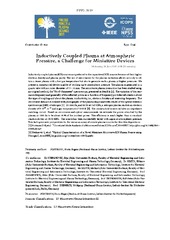Prikaz osnovnih podataka o dokumentu
Inductively Coupled Plasma at Atmospheric Pressure, a Challenge for Miniature Devices
| dc.creator | Porteanu, Horia-Eugen | |
| dc.creator | Stefanović, Ilija | |
| dc.creator | Bibinov, Nikita | |
| dc.creator | Klute, Michael | |
| dc.creator | Awakowicz, Peter | |
| dc.creator | Brinkmann, Ralf Peter | |
| dc.creator | Heinrich, Wolfgang | |
| dc.date.accessioned | 2020-01-04T14:07:59Z | |
| dc.date.available | 2020-01-04T14:07:59Z | |
| dc.date.issued | 2019 | |
| dc.identifier.uri | https://indico.cern.ch/event/727938/contributions/3339169/ | |
| dc.identifier.uri | https://dais.sanu.ac.rs/123456789/6957 | |
| dc.description.abstract | Inductively coupled plasma (ICP) sources are preferred to the capacitive (CCP) sources because of their higher electron density and plasma purity. The use of microwaves for the plasma excitation allows not only to obtain a dense plasma with a low gas temperature but also to generate such a plasma at higher pressures. We present a miniaturized device capable of working up to atmospheric pressure. The plasma is generated in a quartz tube with an outer diameter of 7 – 12 mm. The microwave plasma interaction has been studied using an original method, the “Hot-S-Parameter” spectroscopy, presented in detail in [1]. The variation of the resonance frequency and generally of the reflected power as a function of frequency provides information about the type of coupling and about the plasma conductivity, i.e., electron density and scattering frequency. The microwave data are correlated with photographs of the plasma shape and with results of the optical emission spectroscopy (OES) of nitrogen [2]. At 1000 Pa, and 80 W at 2.45 GHz, a nitrogen plasma reaches an electron density of 3 1019 m−3 and a gas temperature of 1600 K [2]. The miniaturized source includes an impedance matching circuit. Based on microwave and optical measurements we estimate the power absorbed by the plasma at 1000 Pa to be about 60 % of the incident power. This efficiency is much higher than in standard reactors driven at 13.56 MHz. The source has been successfully tested with argon at atmospheric pressure. This fact opens new perspectives for the use as an array of remote plasma sources for thin-film depositions. | en |
| dc.language.iso | en | sr |
| dc.publisher | IEEE | sr |
| dc.rights | openAccess | sr |
| dc.rights.uri | https://creativecommons.org/licenses/by-nc-nd/4.0/ | |
| dc.source | 2019 IEEE International Conference on Plasma Sciences (ICOPS), 22-28 June 2019, Orlando, Florida | sr |
| dc.subject | inductively coupled plasma | sr |
| dc.subject | miniature devices | sr |
| dc.subject | atmospheric pressure | sr |
| dc.title | Inductively Coupled Plasma at Atmospheric Pressure, a Challenge for Miniature Devices | sr |
| dc.type | conferenceObject | sr |
| dc.rights.license | BY-NC-ND | sr |
| dcterms.abstract | Бибинов, Никита; Бринкманн, Ралф Петер; Awакоwицз, Петер; Клуте, Мицхаел; Портеану, Хориа-Еуген; Хеинрицх, Wолфганг; Стефановић, Илија; | |
| dc.type.version | publishedVersion | sr |
| dc.identifier.fulltext | https://dais.sanu.ac.rs/bitstream/id/27641/Porteanu-PPPS-2019.pdf | |
| dc.identifier.rcub | https://hdl.handle.net/21.15107/rcub_dais_6957 |

